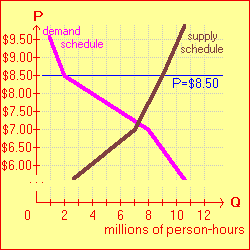|
Like all (above-market) price floors, minimum-wage laws result in a surplus of the item traded. Supply and demand schedules for a particular type of labor are shown in the graph. As we know (pp.
In order to have any direct effect on the market, the minimum wage must exceed the free-market wage. In the graph, an imposed $8.50 wage floor is represented by the blue horizontal line. As can be seen, the labor supply at this level exceeds the demand for labor: that is, the quantity of work sought by workers exceeds the jobs available. This excess, measured in person-hours, is known as unemployment. |  |